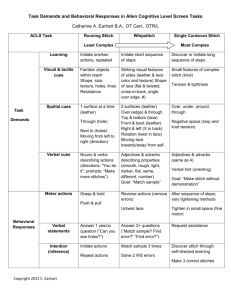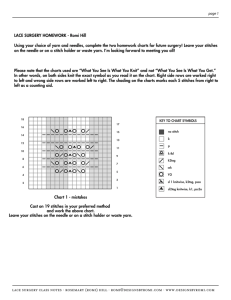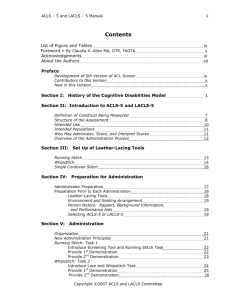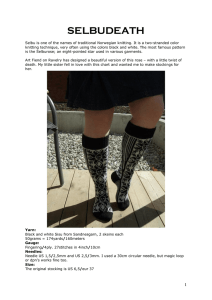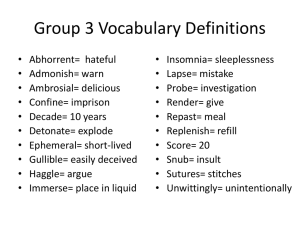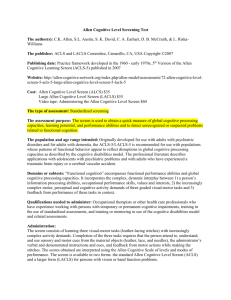Cognitive Level Determination Protocol
advertisement
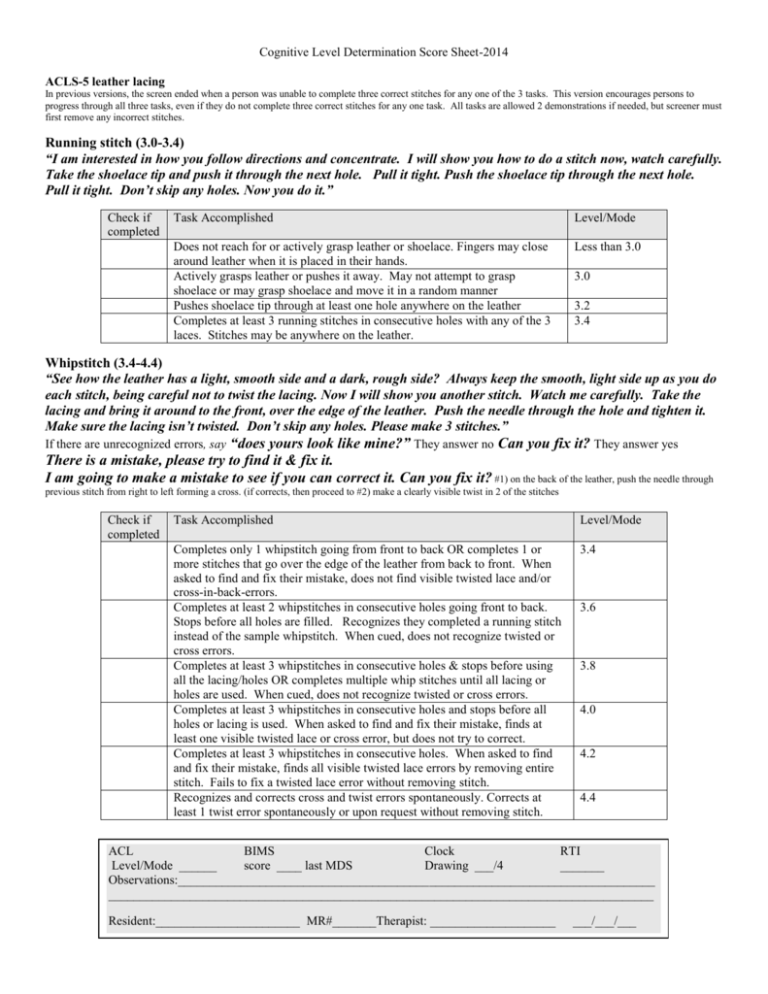
Cognitive Level Determination Score Sheet-2014 ACLS-5 leather lacing In previous versions, the screen ended when a person was unable to complete three correct stitches for any one of the 3 tasks. This version encourages persons to progress through all three tasks, even if they do not complete three correct stitches for any one task. All tasks are allowed 2 demonstrations if needed, but screener must first remove any incorrect stitches. Running stitch (3.0-3.4) “I am interested in how you follow directions and concentrate. I will show you how to do a stitch now, watch carefully. Take the shoelace tip and push it through the next hole. Pull it tight. Push the shoelace tip through the next hole. Pull it tight. Don’t skip any holes. Now you do it.” Check if completed Task Accomplished Level/Mode Does not reach for or actively grasp leather or shoelace. Fingers may close around leather when it is placed in their hands. Actively grasps leather or pushes it away. May not attempt to grasp shoelace or may grasp shoelace and move it in a random manner Pushes shoelace tip through at least one hole anywhere on the leather Completes at least 3 running stitches in consecutive holes with any of the 3 laces. Stitches may be anywhere on the leather. Less than 3.0 3.0 3.2 3.4 Whipstitch (3.4-4.4) “See how the leather has a light, smooth side and a dark, rough side? Always keep the smooth, light side up as you do each stitch, being careful not to twist the lacing. Now I will show you another stitch. Watch me carefully. Take the lacing and bring it around to the front, over the edge of the leather. Push the needle through the hole and tighten it. Make sure the lacing isn’t twisted. Don’t skip any holes. Please make 3 stitches.” “does yours look like mine?” They answer no Can you fix it? They answer yes There is a mistake, please try to find it & fix it. I am going to make a mistake to see if you can correct it. Can you fix it? #1) on the back of the leather, push the needle through If there are unrecognized errors, say previous stitch from right to left forming a cross. (if corrects, then proceed to #2) make a clearly visible twist in 2 of the stitches Check if completed Task Accomplished Level/Mode Completes only 1 whipstitch going from front to back OR completes 1 or more stitches that go over the edge of the leather from back to front. When asked to find and fix their mistake, does not find visible twisted lace and/or cross-in-back-errors. Completes at least 2 whipstitches in consecutive holes going front to back. Stops before all holes are filled. Recognizes they completed a running stitch instead of the sample whipstitch. When cued, does not recognize twisted or cross errors. Completes at least 3 whipstitches in consecutive holes & stops before using all the lacing/holes OR completes multiple whip stitches until all lacing or holes are used. When cued, does not recognize twisted or cross errors. Completes at least 3 whipstitches in consecutive holes and stops before all holes or lacing is used. When asked to find and fix their mistake, finds at least one visible twisted lace or cross error, but does not try to correct. Completes at least 3 whipstitches in consecutive holes. When asked to find and fix their mistake, finds all visible twisted lace errors by removing entire stitch. Fails to fix a twisted lace error without removing stitch. Recognizes and corrects cross and twist errors spontaneously. Corrects at least 1 twist error spontaneously or upon request without removing stitch. 3.4 3.6 3.8 4.0 4.2 4.4 ACL BIMS Clock RTI Level/Mode ______ score ____ last MDS Drawing ___/4 _______ Observations:____________________________________________________________________________ _______________________________________________________________________________________ Resident:_______________________ MR#_______Therapist: ____________________ ___/___/___ Single cordovan stitch (4.2-5.8) Step 1 attempt using sample only ; Hand the patient the sample: “Please make 3 stitches without me showing you how to make them. If you can’t figure it out, I will show you.” If needed, offer encouragement such as “keep trying, this stitch is hard, or you are making progress.” Do not offer problem solving cues at this time. Step 2 attempt with a hint: If not correcting errors, or becoming overly frustrated, offer assistance by saying “Would you like a hint?” Proceed to offer one verbal cue such as “look at how you are going through the hole, is there another way to tighten the lace, or you have the first part right.” Step 3 attempt with a demo if continues to be unsuccessful: “Would you like me to show you how? Watch me carefully. Bring the needle to the front of the leather and push the needle through the next hole towards the back of the leather. Don’t pull the lace tight but leave a small loop in it. Bring the lace to the front of the leather, but this time put the needle through the loop you have made. As you go through the loop, keep the needle to the left of the lace. Pull the lace through the loop. Tighten the stitch by pulling the lace from the back, and then by pulling the long lace end. Make sure the lace isn’t twisted. Please do three stitches.” Check if completed Task Accomplished Level/Mode Does not complete 3 correct single cordovan stitches in consecutive holes after 2 demonstrations. Makes repeated whipstitches or running stitches. Does not recognize errors OR recognizes errors but does not attempt to correct OR recognizes and attempts to correct error by reversing only last action performed Does not complete 3 correct single cordovan stitches in consecutive holes after 2 demonstrations. Makes whipstitch and immediately pushes needle through loop from back as if it were 1 step. Lacing is under but not wrapped around loop OR pushes needle through hole back to front and through loop front to back. Does not recognize incorrect stitch OR attempts to correct an identified error by removing entire stitch and repeating unsuccessful methods. Does not complete 3 correct stitches in consecutive holes after 2 demonstrations. Pushes needle from front to back through hole and loop then pushes through loop twice or through next hole. Stitch not tightened OR needle pushed front to back through hole and loop with needle to right of lace as it exits from back of hole. Stitch not tightened. Errors not recognized OR attempts to correct identified errors by removing stitch and varying direction in which needle is pushed through hole &/or loop. Does not complete 3 correct stitches in consecutive holes after 2 demonstrations. Pushes needle from front to back through hole and loop, and then pulls on lace end to tighten stitch. Does not tighten stitch in demonstrated sequence. Does not direct needle consistently to right or left of lace when pushing through loop. Does not recognize errors OR uncertainty about whether a stitch is incorrect. Attempts correction by pulling harder on lace or varying direction of pull. Does not complete 3 correct stitches after 2 demos. Pushes needle from front to back through hole and loop. Tightens by pulling lace in various ways. Does not tighten in demonstrated sequence. Spontaneously recognizes errors. Attempts to correct errors one at a time by changing methods of untwisting and tightening lace. Discovers successful solutions, but does not repeat these solutions to complete subsequent stitches. Completes 3 correct stitches after 2nd demo. Pushes needle from front to back through hole and loop and tightens stitches by pulling on lace in demonstrated sequence. Discovers successful solutions to correct errors and repeats solutions in subsequent stitches. Completes 3 correct stitches after 1 demo. Tightens in appropriate sequence and so tension matches sample stitches. Completes 3 stitches without a demo but requires one verbal cue Completes 3 stitches without a demo or cue using observation & trial/error 4.2 4.4 4.6 4.8 5.0 5.2 5.4 5.6 5.8 Ask the person to draw the face of a clock, putting the numbers in the correct positions. After he/she has drawn a circle and placed the numbers in position, ask him/her to draw in the hands indicating ten minutes after eleven. Draw a clock Draws closed circle 1 point Inserts 2 hands 1 point Includes all 12 correct #s 1 point Places hands in correct position 1 point Routine Task Inventory Score Sheet: Physical Scale Name_______________________ Date __/__/__ MR__________ Check the level that best describes observed performance or caregiver’s report of performance. Grooming 1 2 3 4 5 Ignores personal appearance. May not hold head up or keep head turned to the side to cooperate with caregiver Aware of caregiver’s help. May move to assist caregiver or actively resist. Does daily grooming of teeth, washing face/hands. Supplies must be placed in front of them or they may quit before the task is finished and require prompts to finish. May need 1:1 supervision. May be unconcerned about dirty hair, unkempt nails. May not be safe with sharp or hot objects (razor, curling iron.) May not be aware what time of day grooming is usually done. Initiates and completes grooming. May neglect the back of the head or body or miss spots they cannot see. May be concerned about appearance and ask for helping selecting and applying grooming products. Initiates and completes grooming. Dressing 1 2 3 4 5 Ignores clothing unless cold or uncomfortable Aware of caregivers efforts to dress. May alter position to assist hand in sleeve, etc. or may not use enough force to get the garment on without help. May resist getting dressed. May need help for sitting/ standing. May need help adjusting clothing throughout the day to keep them on correctly Puts on shirt, pants/ skirt, underwear, and shoes. Clothes may be laid out by caregiver. May need help with fasteners. May be unconcerned about the appearance of their clothing or be unaware of the need to change clothes based on time of day, weather, soiling, etc. and resist requests to change. May be unconcerned about errors such as garments on backwards, or underwear on top Follows a routine for getting dressed without help. May have errors in button alignment, shirt not tucked in back or labels showing, but corrects when pointed out. May disregard errors in back or poorly matching clothes. Selects own clothing and dresses without error Bathing 1 2 3 4 5 Bathed lying in bed or lifted into tub Assists caregivers efforts to bathe, may stand or sit while soap/shampoo are applied by caregiver. May stand/sit as directed, may use grab bars when directed. May be scared of falling & resist entering shower. Can get in/out of tub and use bathing articles without help. May need assist w/water temp, to bathe or dry all areas thoroughly. May need help to sequence through the use of toiletries Follows a routine at usual time for bathing without help or set up. May need help to keep supplies handy for use. May leave bathroom unkempt. May need to be checked to be sure back of head is washed, deodorant applied. May need help finding supplies if not in usual location. Bathes without help and checks own quality. Toileting 1 2 3 4 5 No awareness of need to void or does not communicate need for help. May cooperate with bedpan placement Aware of need to void & attempts to go to toilet. May not know where the bathroom is or not allow enough time to get there. May have trouble opening door, leave door open when going, adjusting garments, or need cues to use toilet paper effectively & remembering to flush Recognizes need to go, finds bathroom, opens door, turns to sit, manages clothing, voids, wipes, and pulls up pants. May leave door open & forget to flush. May need cues to wipe clean, wash hands, zip, or tuck in shirt. Cares for self at toilet completely. May need clothing errors pointed out or need reminders to go before leaving home Can look around for a bathroom in a new setting without direction Name_______________________ Date _/_/_Therapist_______________ Routine Task Inventory Score Sheet: Communication Scale Check the level that best describes observed performance or caregiver’s report of performance. Listening/Comprehension 1 Locates direction from which sound is coming when sound accompanied by calling name or other additional cures. May not move head or eyes to respond, may be very slow to respond (1-2 mins.,) may not show understanding of words but may respond to sounds like a bell or name. 2 Understands & follows simple directions using single words/short phrases related to immediate physical comfort. May not sustain attention unless accompanied by demonstrated action. May require: repetition, a slow rate between words, a long duration of spoken word. 3 Understands & follows simple directions & forms immediate memory for messages comprised of phrases or short sentences related to immediate personal interests in surroundings. May be distracted by irrelevant stimuli, misunderstand information, not maintain focus on topic, or may not understand a message given at a normal rate & duration 4 Understands & acts on info contained in simple conversation about highly familiar topic & maintains focus on topic that conforms with past experiences. May not understand new info, new info may need to be repeated slowly or accompanied by pointing to locations, showing how, or writing down a message. May not listen to the conversations of others. 5 Listens to & understands conversations & new info related to past & present experiences. May understand future events (such as warnings) when cause & effect is demonstrated may not understand explanations in new situations & ignore warnings, may not request clarification or anticipate the need for additional info, may present own view but not understand the points of view of others. 6 Understands conversations & new info related to planning & organizing future events. Considers hypothetical possibilities when verbally expressed & anticipates safety hazards. Talking/Expression 1 Communicates pain or fear by verbal expression and/or gesture. May not: stop screaming, gesturing when problem has been acknowledged, communicate displeasure or discomfort, initiate a sound/gesture for long periods of time 2 Communicates physical comfort/discomfort/fear via single words and short phrases. Words may be produced at a very slow rate, spoken very softly or unnecessarily loudly, & may contain sounds that are unintelligible to the listener. 3 Communicates simple messages via phrases & short sentences related to immediate interest in surroundings. May not: maintain topic beyond current manual actions, present info in a logical sequence. May include irrelevant info, jargon, neologism, or may not adjust rate, tone, volume, speaking distance when requested. 4 Initiates communication re: immediate goal or need for assist to achieve a personal goal. Converses about highly familiar topics related to past experiences. May interrupt others, include too little or too much info, have word finding problems for common words, or use abstract words incorrectly. May adjust rate, tone, volume, speaking distance only upon request 5 Communicates interesting & irrelevant info from past & present experiences. May not: restate or revise info according to listener/social circumstance, respond to subtle cue to revise message, or may have word finding problems for seldom used words or have difficulty learning new words. May react to different points of view by interrupting/talking. May not shift between speaker/listener roles and contributes too much or too little to conversation. 6 Communications go beyond personal experiences to consider experiences/needs of others and to anticipate events that could have an impact on the lives of others Reading/Comprehension 1 Locates & gives some indication of recognition of pictures, objects, letters, own name when visual stimuli is accompanied by verbal, tactile, &/or gestural cues. May not show consistent recognition, be very slow to respond (1-2 mins) or may not be able to speak 2 Reads single words & short phrases related to immediate physical comfort or familiar addresses, greetings, traffic signs. May not read for up to a minute or require large print with a single word per page or may be hard to hear/understand if reading aloud. 3 Reads & repeats back or answers questions on cue to 3 simple sentences related to immediate personal supplement Adapted from Katz-Allen 2006 Routine Task Inventory RTI: Communication Scale situation or from familiar headlines, ads, cartoons, or bills. May take 1-2 mins to read the sentences, may not comprehend the relationship between sentences, may not maintain focus on the context, or may misunderstand info according to immediate personal needs 4 Reads & gives a verbatim report or answer to questions about 1-3 paragraphs related to a topic of familiar interest and experience. Reading rate may be decreased. New info may be ignored or misinterpreted. May not establish a connection between info and personal actions. May ignore most written material. 5 Reads & can answer questions or restate content of lengthy material on familiar topics. May read newspaper, magazines. May not relate precautions in new situations, commercial product use/road hazard to own situation. May not be able to answer questions or restate content of new material. May require demo to comprehend reading of new info. 6 Reads & comprehends new info & applies it when organizing/planning future actions Writing/Expression 1 May write own name or make random marks. May be very slow to respond in marking, name may be hard to read or an approximation, may stop before name is complete, may not grasp pencil 2 Writes single words/phrases related to physical comfort or familiar example. May not write when an immediate elimination of discomfort is needed, may be illegible to unfamiliar readers, may take 1-2 mins to write 1-3 words, may require repetitive demo of writing a word. May not grasp pencil. 3 Writes simple messages via phrases related to immediate personal interest in surroundings or familiar example. May be slow to start, fail to complete message once started if distracted, write lengthy illogical messages, or may not make a connection between writing and communicating. 4 Writes of types (if already knows how) 1-3 simple paragraphs about highly familiar topic or a letter containing a personal request. Into and concluding sentences may not be present, supporting details may be sparse or over inclusive, may repeat the same ideas over & over, may be slow to write a dictated message. Messages may not be delivered. Letter may not be properly addressed or have necessary stamp. 5 Writes or types (if already knows how) multiple paragraphs that restate known info or have simplistic content. May not: consider the reader’s response, revise material for different readers, adjust quantity/quality according to deadlines or external factors such as a birthday. May avoid new info or reproduce it inaccurately. 6 Writes or types multiple paragraphs and pages from an objective point of view, considers reader, follows an organized format, and delivers material in a timely manner. supplement Adapted from Katz-Allen 2006 Routine Task Inventory RTI: Communication Scale
